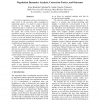Free Online Productivity Tools
i2Speak
i2Symbol
i2OCR
iTex2Img
iWeb2Print
iWeb2Shot
i2Type
iPdf2Split
iPdf2Merge
i2Bopomofo
i2Arabic
i2Style
i2Image
i2PDF
iLatex2Rtf
Sci2ools
IAT
2007
IEEE
2007
IEEE
Negotiation Dynamics: Analysis, Concession Tactics, and Outcomes
Given that a negotiation outcome is determined to a large extent by the successive offers exchanged by negotiating agents, it is useful to analyze dynamic patterns of the bidding, what Raiffa calls the “negotiation dance”. Patterns in such exchanges may provide additional insight into the strategies used by the agents. The current practice of evaluating a negotiation strategy, however, is to primarily focus on fairness and quality aspects of the agreement. There is a lack of tools and methods that facilitate a precise analysis of the negotiation dynamics. To fill this gap, this paper introduces a method for analysis based on a classification of negotiation steps. The method provides the basic tools to perform a detailed and quantified analysis of a negotiation between two agents in terms of dynamic properties of the negotiation trace. The method can be applied to well-designed tournaments, but can also be used to analyze single 1-on-1 negotiation. Example findings of applying the ...
| Added | 02 Jun 2010 |
| Updated | 02 Jun 2010 |
| Type | Conference |
| Year | 2007 |
| Where | IAT |
| Authors | Koen V. Hindriks, Catholijn M. Jonker, Dmytro Tykhonov |
Comments (0)

